A blog about the ups and downs of being a creative type - art, rpgs, writing and game design.
Don't wanna be here? Send us removal request.
Text
An interesting take on AI
An interesting and well thought article on generative AI:
https://www.nplusonemag.com/issue-48/essays/eat-poop-you-cat/?highlight=Rachel%20Ossip
Its a long read in an age where people complaining if they are presented with anything longer than a couple of sentences but worth it I think.
One of the questions I think artists need to ask is how we can approach AI creatively rather than just be scared by it and hiding or getting angry. If we really are creative (actually lots of artists are not and just know how to create a very limited kind of image in very safe common ways) then there is a real challenge there and one approach artists can take is to exploit the quirks of how AI works to reveal and highlight aspects of our humanity and our culture and how it gets absorbed, filtered and distorted by AI and might end up saying far more about us than we might think.
0 notes
Text
DARKPORT, CITY OF LOST DREAMS







I have been working on and off on images of Witching's main city, Darkport, for the core Fortune's Wheel game setting and was not happy with the results. Recent experiments with using the Midjourney AI have started producing the sort of results I wanted though. I'm still trying to get the vertical aspect (the city is built on steep cliffs either side of a river as it enters the sea) and getting it to do closeups of the harbour is proving difficult, but so far I 'm very happy with it. A bit of extra work in Photoshop and I think these may do nicely.
These are a selection of images from Midjourney. It creates them in batches of four and you can then choose which of these to create variations or larger images from. Can you imagine living and having adventures in a city like this? One that sits on the edge of other realities that have been seeping through and shaping the city for centuries and where both its inhabitants and buildings can sometimes be made from peoples dreams, nightmares and imaginations?
#fortunes wheel#tabletop rpg#rpg#rpgs#digital art#ai artwork#roleplaying games#art#tabletop role-playing game#midjourney
0 notes
Text
Art and Fortune's Wheel
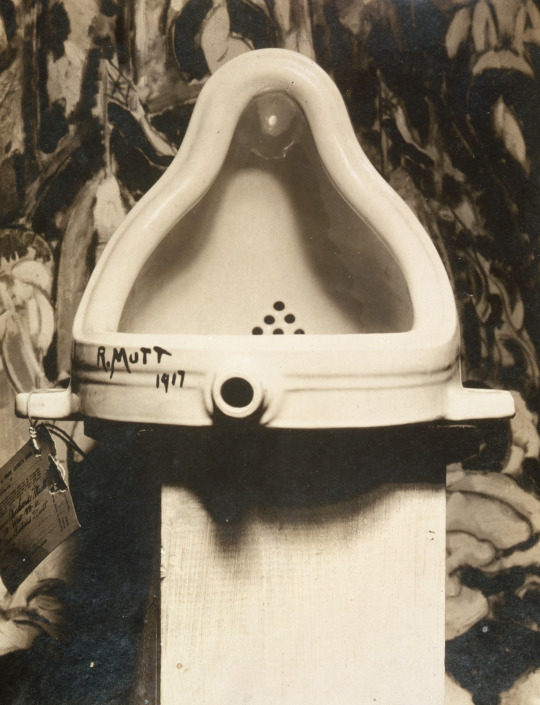
Way back in February 2016 I posted about Digital vs Traditional Art and promised a part two. Then Brexit happened upending my world, my day job swallowed up my free time, and I embarked on a crazy and very difficult process of immigrating to Canada right in the full blast of Covid. My attention to posting here wandered, but my interests didn't. Part two has actually been the rise of AIs in art - opening even bigger questions than the traditional vs digital debate. AI art is really pushing the issues compared to this, and I'm not sure how much my original point in my earlier post about art as something that has always seen innovations still holds with AIs. I think the closer example in fine art is probably the work of conceptual artists drawing on Marcel Duchamp's 'ready mades' where people inevitably end up asking 'is it art' and 'who really created this'?

Is AI art really art and who really created it, the AI or the person seeding/directing it - and is that the creator the AI or the people using it. If the AI is learning from inputs it is getting and the images it is generating is it even a single person or everyone involved in 'training' the AI? What I am seeing at the moment is in an intriguing mix of people taking what an AI gives them (and sometimes passing it off as created by them without an AI) or trying to find ways to direct and shape the results using their own existing skill sets and new linguistic ones they are learning with text based AIs. The questions still seem very open to a range of answers we are still struggling to find.
Back in 2016 I also suggested I was going to tie the questions about art to my Fortune's Wheel game. So here for anyone who cares is the link. Hybrid Artifacts. The game system and philosophy behind Fortune's Wheel is the same as my art - finding links, commonalities and variations between things from the recent and distant past and especially from my own experience of growing up Hauntologically, caught between promises and threats of unrealised pasts and futures I can't escape.

https://youtu.be/xZWD2sDRESk The arrow of time in Fortune's Wheel always seems to point inexorably to the 1970s and early 80s. It was, after all, the time in which roleplaying games were fruitfully born into the wider world and shared their infancy and it is also when I started playing them. It is also the time when my worldview really formed - spurred on by discovering the music and cut and paste lyricism of David Bowie.
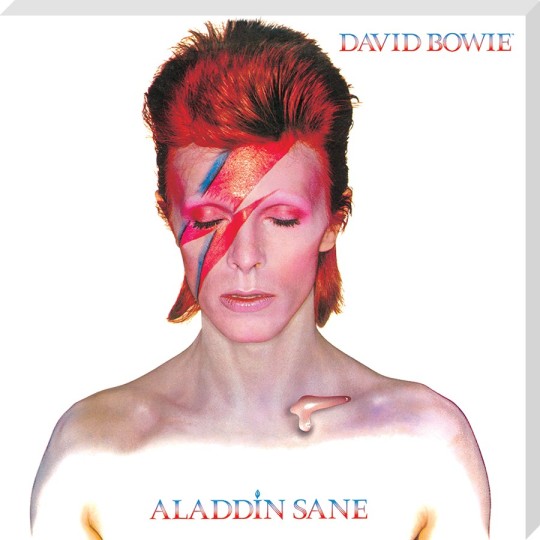
I used to cut and paste my toy soldiers - actually cutting off their limbs and repositioning or transplanting them, gluing them together again as new figures - hybrid artifacts. That is why I use Hybridartifacts as a tag/nickname. It is simply what I do. My digital art does the same, and so actually does AI art. All very post modern perhaps?
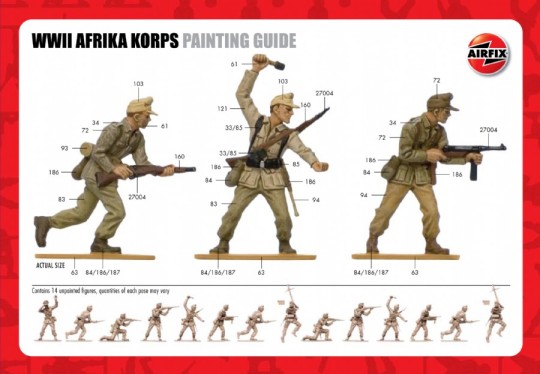
Witching is a pastiche setting of my childhood and Fortune's Wheel has a system based on cutting pasting ideas, concepts and words together to create new things on old shoulders. It is just thinking like a glue stick that gets on your fingers and ends up sticking unexpected stuff together. I decided on using Tarot because you create hybrid interpretations from the juxtaposition of images that are symbolic artifacts of the past - but which some feel point to some intangible possible futures.
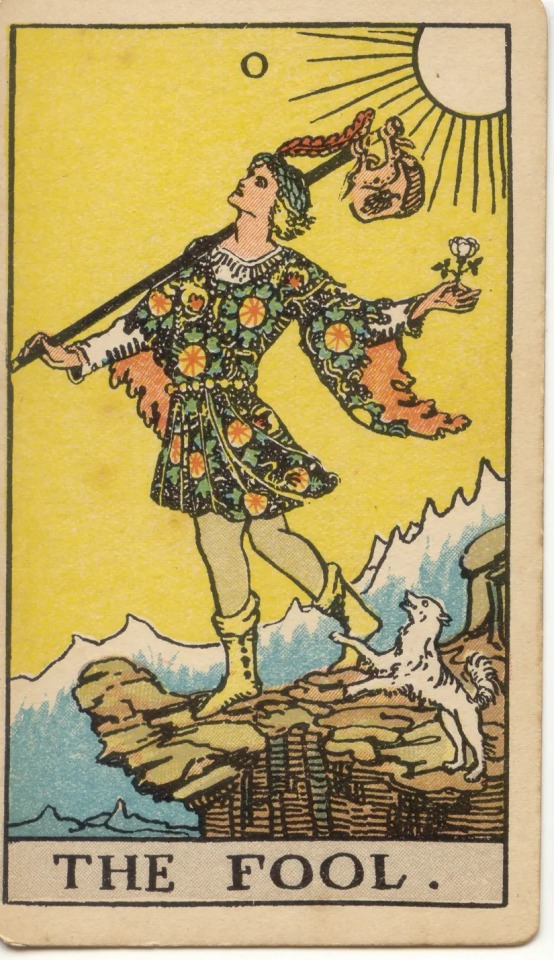
Of course it is all supposed to entertain and delight, and you can play the game without even actively considering the principles behind it, but should anyone be interested in them, the clues to them start here.
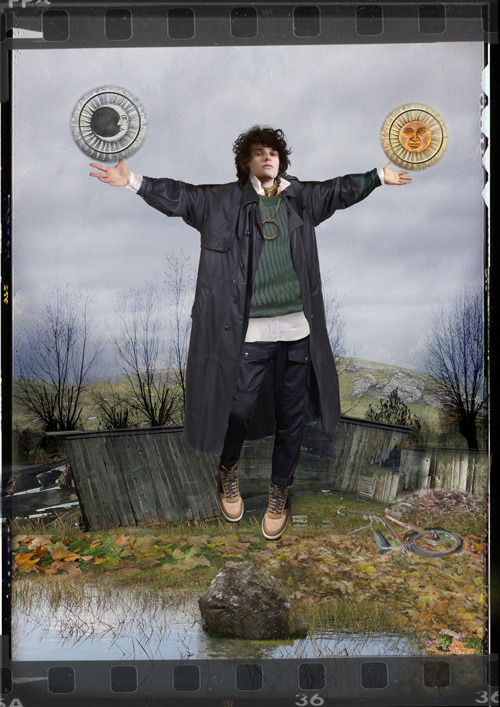
1 note
·
View note
Text
AI art? with Wombo Dream
I spent quite a bit of time experimenting with the Wombo Dream AI image generator, mostly using the Android app on my phone, but there is also a web based version. After a while I started seeing lots of people posting images created with it on Facebook and I got a bit fed up with how they all look like the same artist created them. As AIs go, this one it's own very distinctive style. The results look great, but the composition can be all over the place and it is very hard to direct to get a specific result without tying it to a seed image. These are some early ones I did:
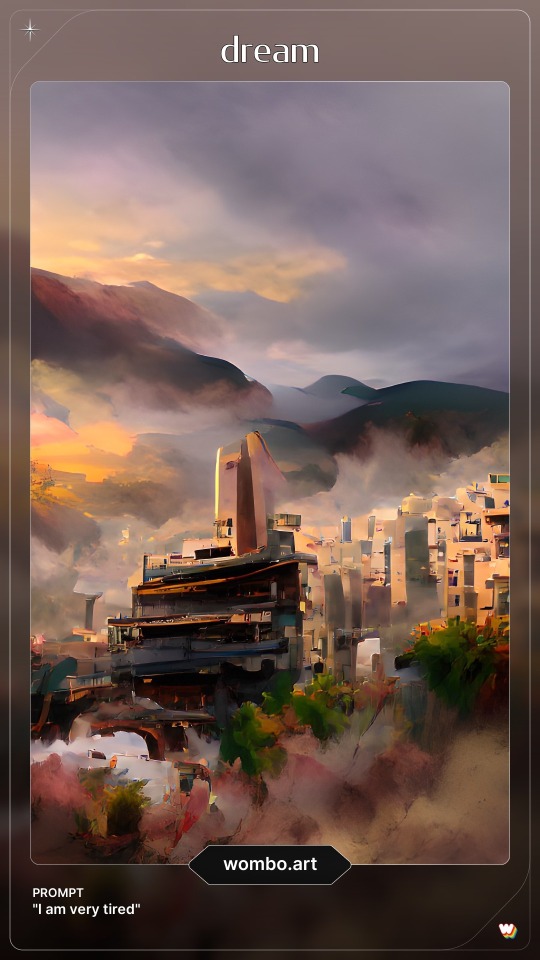
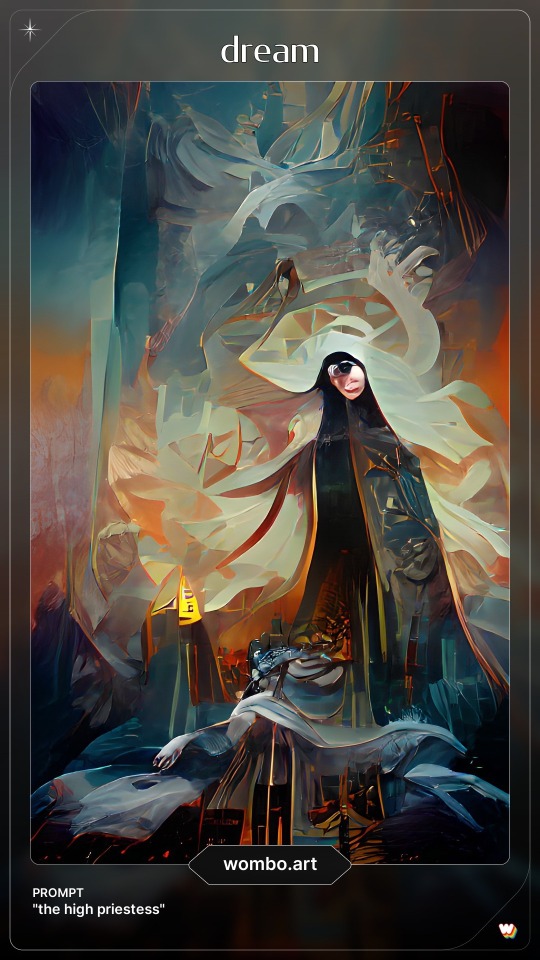
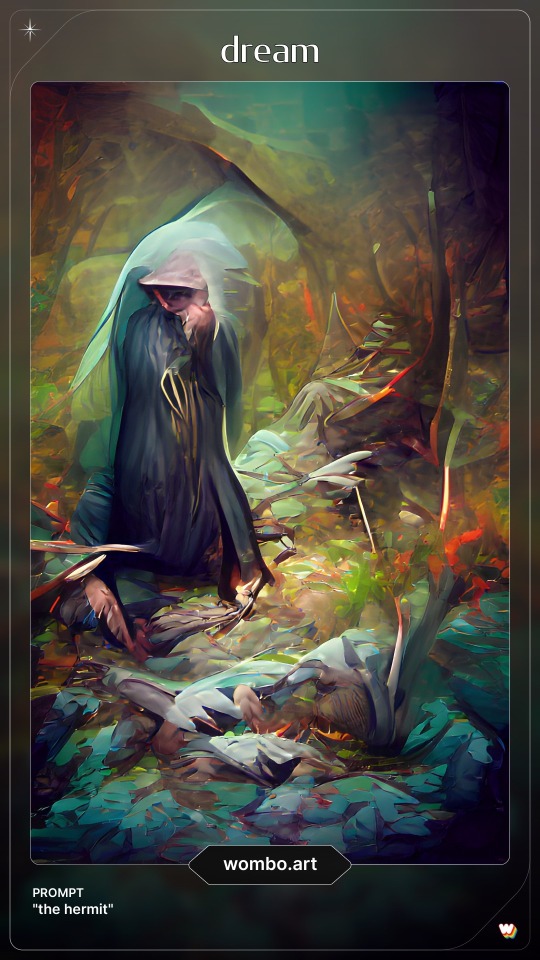
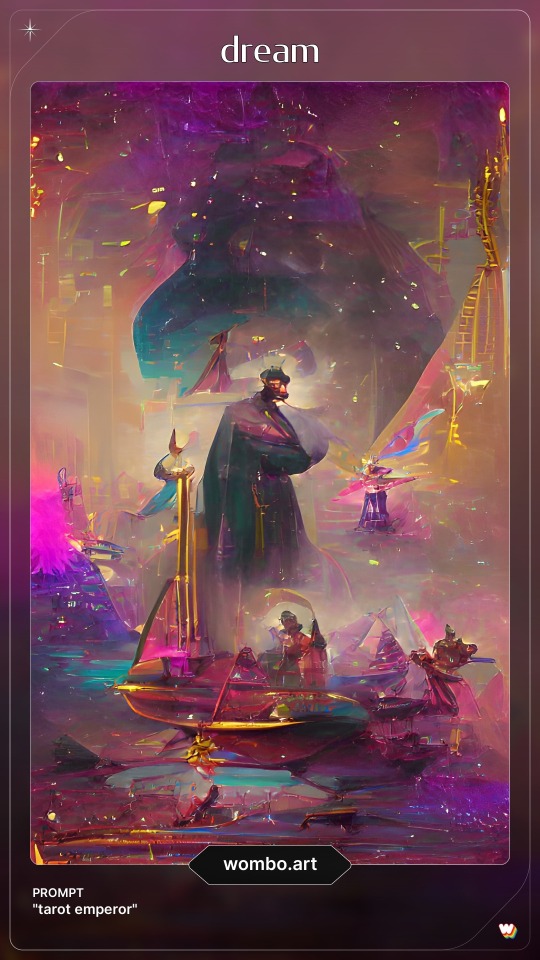
It does let you choose some basic styles as well as input seed text, but doesn't pick up on style keywords and tends to interpret the seed description pretty flexibly. Choices have improved since I first started playing around with it, but many are now pay to use. There is also an option to use a seed image which does help push it in a particular direction and can be used to direct the composition a bit more. Here are some examples done this way,
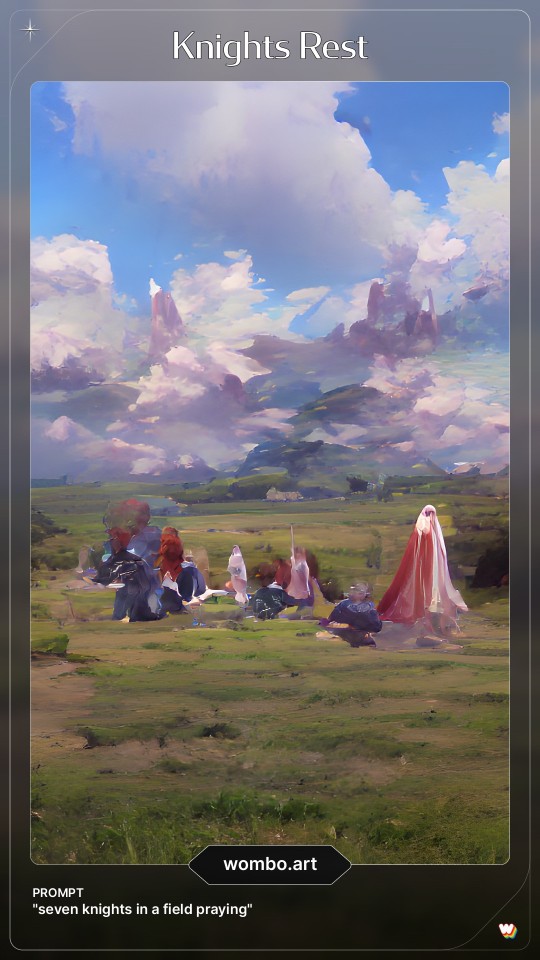
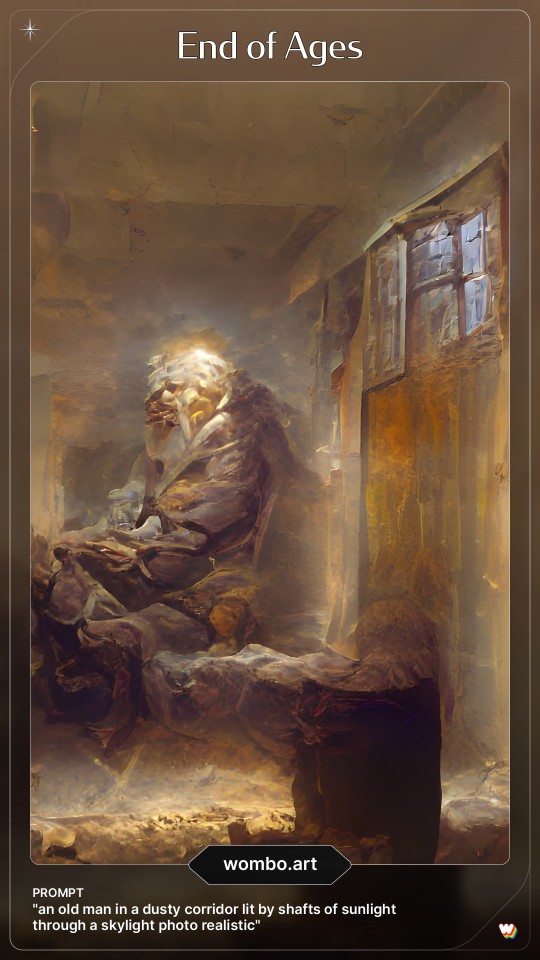
You can also control the strength of the seed image you input, this is one using a photo of a castle set to 'strong'. It starts to feel more like you are just applying a funky art filter at this point, but the results are at least more recognisable.
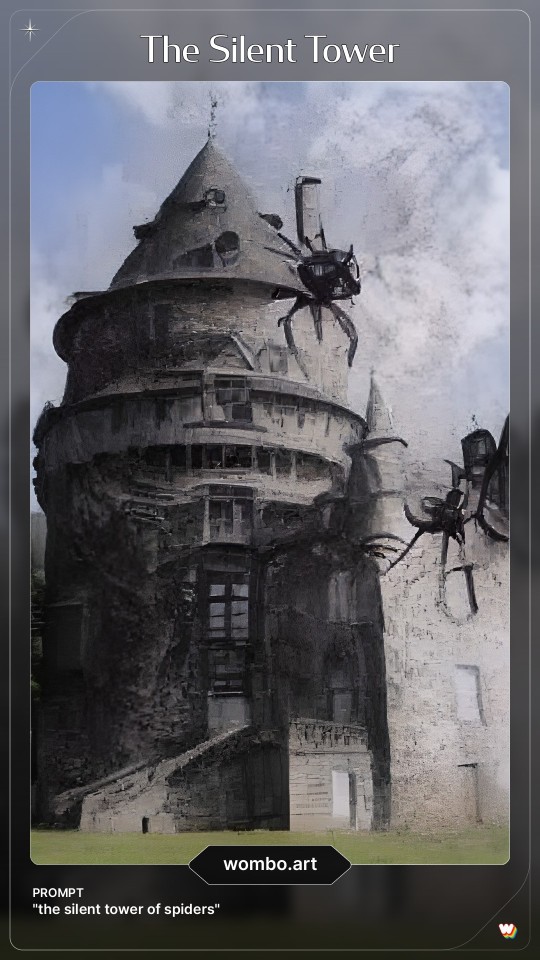
I just noticed when creating these last three that you can add a title, Nice touch. I am expecting to see several Tarot decks created with Wombo Dream. Creating Tarot decks is a time consuming art, and the best really take into account the traditional symbolism of the cards. Hard to do without a seed image, and it strikes me that using the Rider Waite Tarot as the seed may actually get the best results, but I am expecting the ones I see to be awful. Some heavy postwork may also be called for to make them feel more unique. Here is the Fool card, using the Pamela A 'Roses and Lillies' deck on a strong setting and the steampunk style seed.
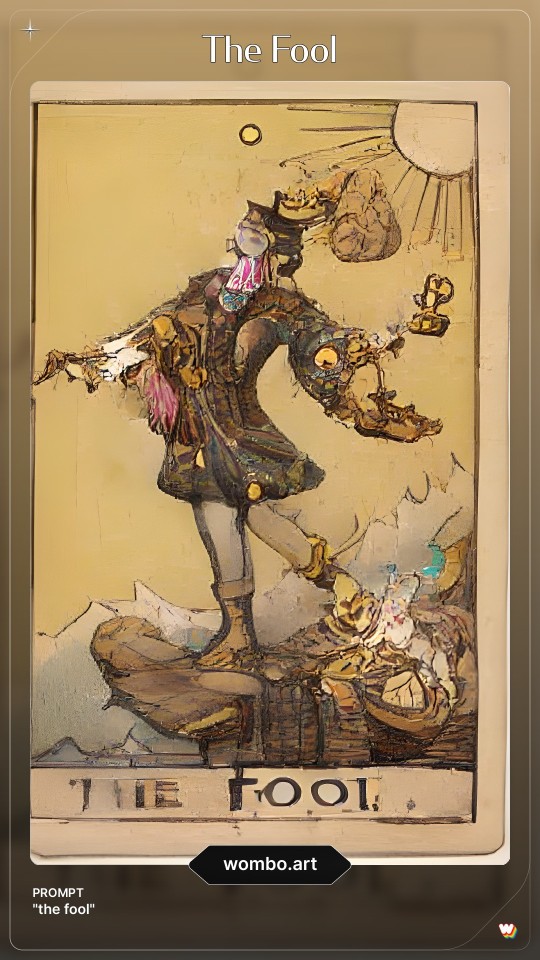
After I threw a few filter effects on it in Photoshop and combined it with the original image again.
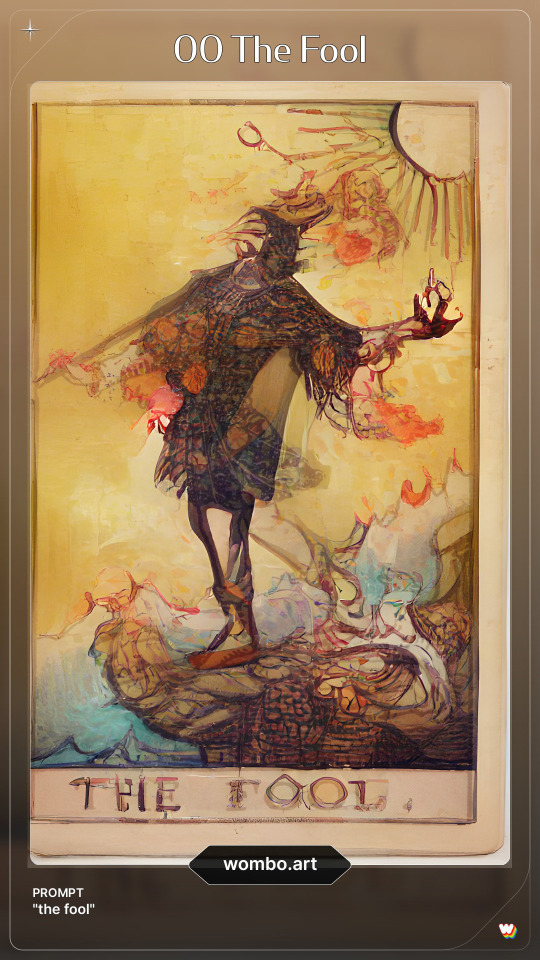
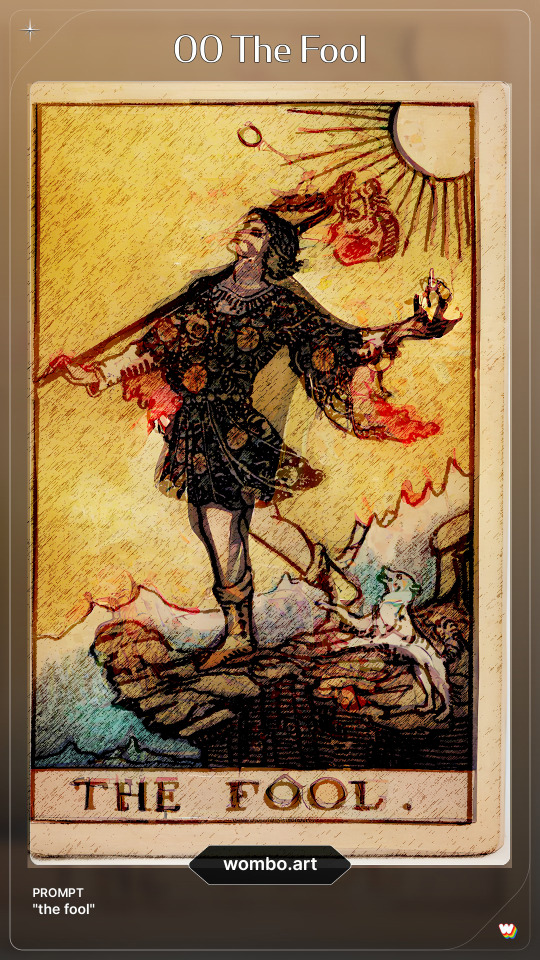
1 note
·
View note
Text
AI Face Generation While I am still experimenting with AI image generation and how I might be able to make use of it in my art (without sacrificing my own style) I have also been looking at face generators. Face generators are something that I can use right away very easily in my art. I often put people in my art so these can be a handy alternative to using bits of photographs of people. I actually manage really well with blending tiny bits of photographs so what I have mostly been using this for is getting bits like jaw lines and ears to use, though they can also be a great source of skin textures.
The more general AIs like Mid Journey struggle with creating faces and the free ones like Wombo Dream and Crayion just make a horrible mess with or do not render at all. There are a couple of dedicated face generators that I have been experimenting with for a year or two that work very well, so I will be comparing them here. The first is This Person Does Not Exist. It is quick and easy to use and free. Most of the time it does a really good job, but occasionally it gets a bit wonky (it struggles with thin glasses a lot, often only rendering half and hats can get really bizarre). Every now and again it creates nightmare faces around the main one. Use it enough and you will see what I mean. Here are a few faces generated by it:




Pretty good results - and very handy for people who want a character portrait for a tabletop roleplaying game with a modern setting. Which makes me wonder if anyone will ever make one that does different historical time periods? I suspect it needs a lot of quality images to work from though, which will be lacking for most historical periods. It may be possible to have a database for training an AI using Victorian and later photographs though and Victorian ones may even be ideal because the poses tend to be full face and kinda stiff. Creating three quarter faces seems to result in things like oddly angled eyes, and this face generator avoids profiles. The second is Face Generator which does have subscription plans but can do a good job in the free version if you just want to play around with it. The big advantage of this one is that you can control the parameters of the face before generating one - choosing gender, age, skin and hair colour. You can even control the face angle a bit and choose an expression. While This Person Does Not Exist can create a mix of ages, genders and races it does it randomly and mostly creates Caucasian adults. If you want Black or Asian faces it falls into that unfortunate category of AIs that reflect the racial biases of western culture as a whole. Face Generator makes a very welcome change. It does mean it is slower to use as you have to set up the parameters, and the images are smaller if you use the free downloads.






For versatility Face Generator wins hands down, but I actually prefer the overall results from This Person Does Not Exist which feel more natural to me. These are a couple of great sites though and have obvious uses right now as they are.
0 notes
Text
Free AI Art Creation (for fun) Following on from my previous post on AI created images, here are some done with Craiyon (previously Dall.e mini, they recently changed the name) which is free to use but the individual images are very low resolution.





It struggles with the human form but does take art direction fairly well. The more descriptive you get the better if you have a particular image in mind. Adding artists names and terms like cinematic, photo realistic, painterly and so on can also push an image in a particular direction.
Great to just play around with but as this is a free to use AI it is lo res so pretty much useless for artists and illustrators (or art directors) to use. They say you may be able to make larger images in the future, but I imagine this really comes down to server capacity.
1 note
·
View note
Text
Exploring AI Art
I'm seeing a lot of people experimenting with AI art. I have been experimenting with several for a little while now because I find it fascinating. Some, like Mid Journey, are getting so good these days that they are creating interesting art of their own I'm reluctant to do post work on. As an artist I find the results tend to lead a composition too much when I use them as a base to do my own art from though. Which leaves me using them as texture generators or perhaps ways of creating backgrounds (with no subject I can add in my own). This is a base image generated by Mid Journey (Keywords 'Lost girl in a window'
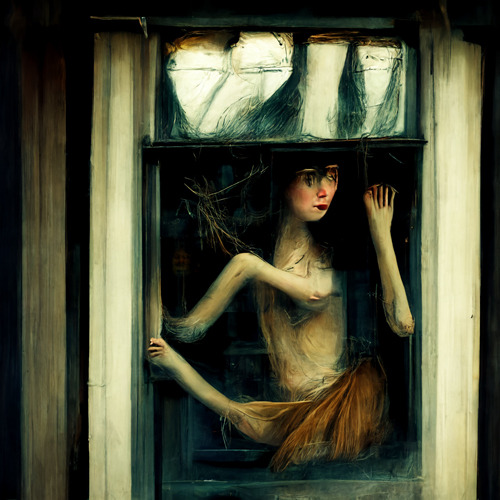
and this is the same image with some post work in Photoshop using my usual micro-collage overlay technique
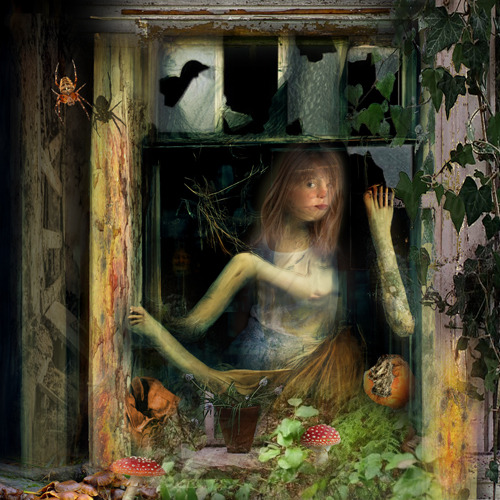
Its interesting - the base image felt like it was done by Dave McKean while the one I worked on is more in my style and actually very like some of my first experiments in digital art. This is one I did back in 2003. Digital, but no AI.
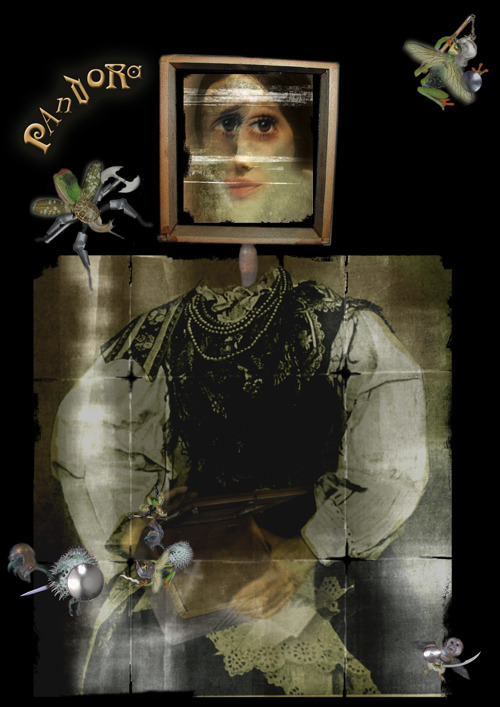
I created a few other images in Mid Journey I'm toying with working with. Mid Journey creates images from keywords in blocks of 4, but some work better than others. You can choose to create a variation or upscale any of the four you want. Here are a couple I created with the Keywords 'Highwayman sitting in the rain beneath a gallows tree'
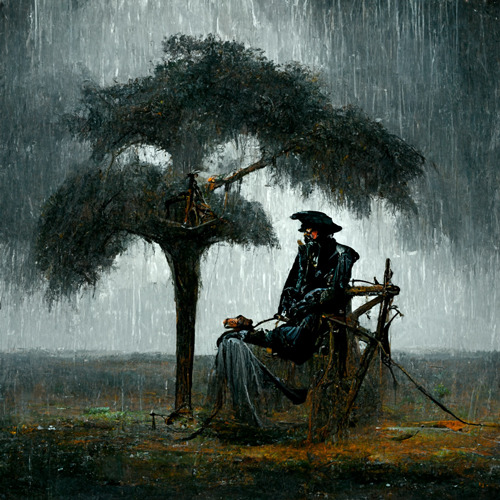
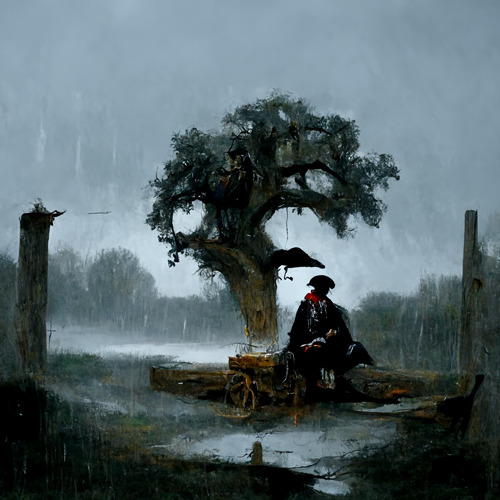
and four with the keywords 'Wooden Puppet Meat Head'
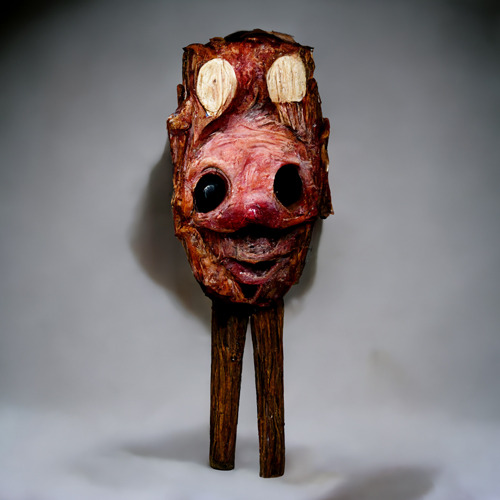
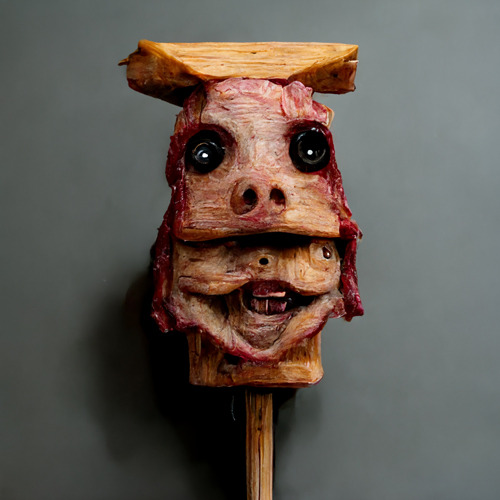
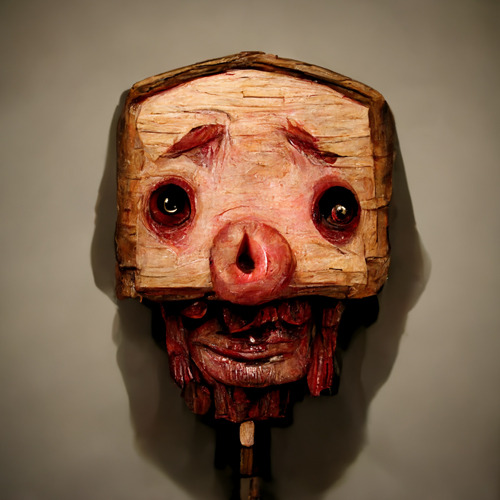
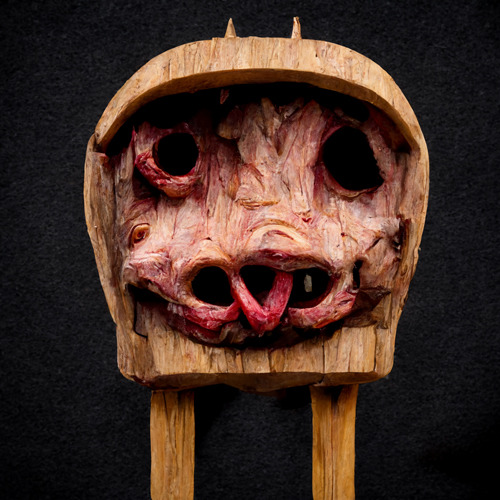
I also did some experiments using other AI art apps I was not so happy with. Wombo Dream creates results very quickly and easily but they are all very much in its own style that's incredibly distinctive and hard to do much with. I can see people using it to create images that will have a 'wow factor' for anyone who has not already seen hundreds of similar AI images already or to do something like generating quick and easy Tarot decks. Wombo Dream uses seed words and seed image styles, but its not as able to be directed as Mid Journey. Then there are ones like Deepdream and Night Cafe - experiments so far suggest to me these are a great way to create image filters in the style of different artists. You input a seed image and then a style one and it processes the seed one in the style of the second image. There may be more you can do that I have yet to discover though. I am on a wait list for Dall.e 2 which looks to be more like Midjourney and could be promising. There are also lots of AIs in Githubs that take a bit more work to setup and use, and all sorts of other AI image generators. I have been experimenting with face animators and generators as well like Fakerface and This Person Does Not Exist. More on these later.
1 note
·
View note
Text
A New Twist
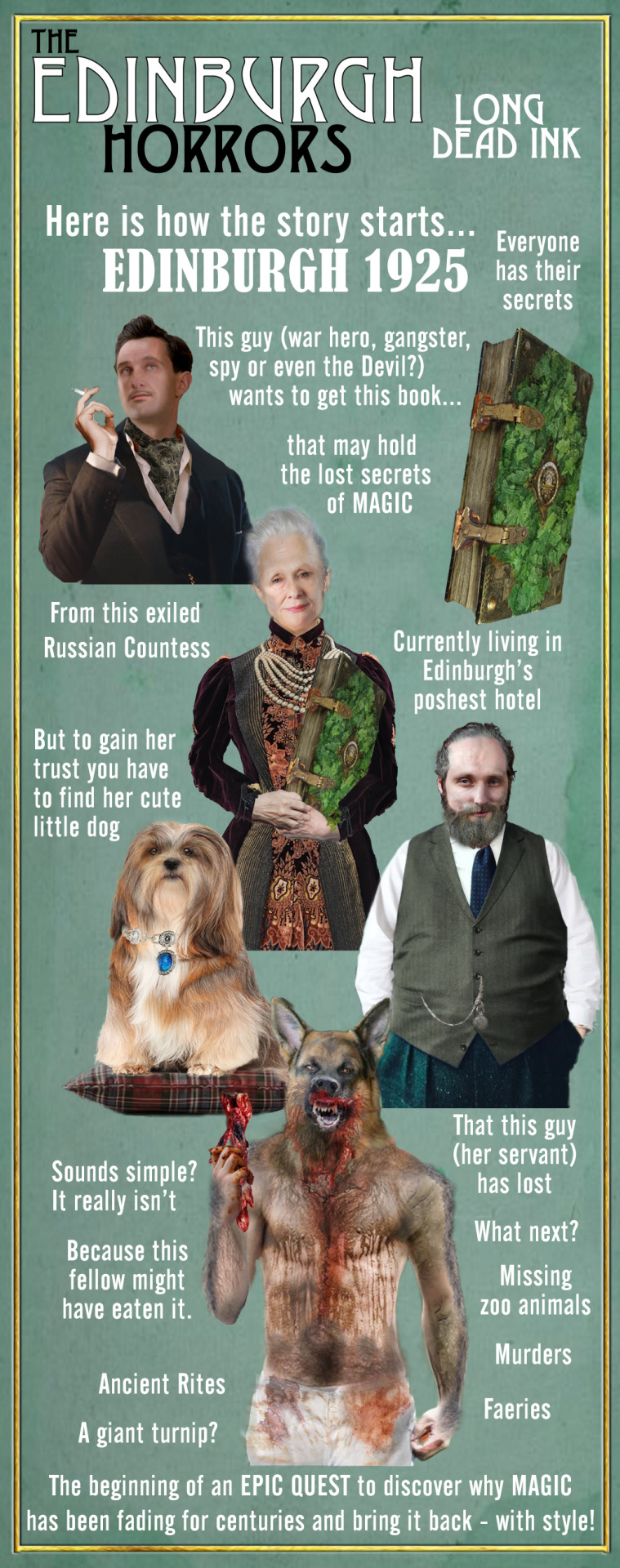
I have decided to flip round how I have been approaching releasing the Fortune’s Wheel rpg. Instead of starting with the big guns (the Witching setting) and a full game system, I am going to release an adventure with the game system built in so you can just pick it up and play while learning the game system as you go.
#Fortune's Wheel#rpg#roleplaying#gaming#game#stories#story game#story games#horror#fantasy#fairies#fey#faerie#magic
0 notes
Text
Faces + Technology = Ouch!
It has been far too long since I last posted here. Changing from a part time job to a full time one with long travel times means I have much less time to do artwork. I just finished reading a couple of interesting articles that do have a connection to how I create my artwork though and felt it made sense to write a post about them. The overlay techniques I use were inspired by both my own experimentation in Photoshop but also by reading about Sire Francis Galton's experiments using composite photos to try and create an image of a 'common criminal type' that could be used by police to arrest people just based on their facial type indicated criminal tendencies (and presumably also to help 'breed out criminality using his other passion, Eugenics). These sorts of tendencies (the tendency to think one can detect common types by face structure, not any perceived tendency to actually be a criminal if you have a particular facial type) seem to enjoy brief periods of resurgence and popularity and perhaps we are seeing one happening now. If you are interested in faces and psychology as I am, the two articles make interesting reading. Here they are for you: https://www.theguardian.com/technology/2018/jul/07/artificial-intelligence-can-tell-your-sexuality-politics-surveillance-paul-lewis https://medium.com/@blaisea/do-algorithms-reveal-sexual-orientation-or-just-expose-our-stereotypes-d998fafdf477 Personally I am with the second article rebutting the study and feel that we are also perhaps tending to confer a level of reliability to technology and studies that simply does not exist. In a sort of pseudo-theological sense some are perhaps using them to replace a loss of faith and sense of certainty and security we got from the idea of God in some approaches to faith with a similiar sense in regards to technology and science. Of course mature thinking scientists understand that that their work is subject to human error and beliefs, that we cannot strip away our fallibility and cultural perceptions from any of our process and methods - that in fact they are inevitably products of them. That's why in a quest to try and increase reliability they open them to things like peer review and critique and seek repeatability. Those structures of critique and reflection have been shown to be flawed however: https://www.nature.com/news/1-500-scientists-lift-the-lid-on-reproducibility-1.19970 https://www.theguardian.com/commentisfree/2015/aug/28/psychology-experiments-failing-replication-test-findings-science http://journals.sagepub.com/doi/abs/10.1177/014107680609900414?ssource=mfr&rss=1& https://www.jove.com/blog/editors-notes/studies-show-only-10-of-published-science-articles-are-reproducible-what-is-happening/ Attempts are being made to address these sorts of issues of course: https://phys.org/news/2013-09-science-crisis.html It's not that there is anything particularly wrong with all of science (or technology) per se, the real problem is that we may invest far too much in and can become far too trusting of it. Just look at the recent news about British Police Forces using facial recognition despite it having been shown to create false positives for matches with criminals 80% of the time and how despite this they are still pressing ahead and using it. Some tech salesman has sold them a con, that facial recognition is reliable enough for safe use. It really isnt - not in policing or in places like biometrics in airport security. At least not of and in itself - it absolutely has to be backed with the very thing they seek to remove any need of - humans checking the results. Back to the whole idea of using faces to say what someone sexuality is, or if they are criminals etc. The rebuttal article makes some very sound points about things like grooming and facial angles of shots. It reveals just why using uncontrolled images sourced from a dating site is, quite frankly, stupid science. Moronic even. It has overlooked the simple fact that for it to be a valid study of anything other than how people like to present themselves on dating sites that actually for the purposes of their experiment every single photo 100% absolutely has to be taken in an identical fashion. Passport photos do attempt this, while dating site profile photos don't, so perhaps if they had used passport photos they might have something, but they didnt. Instead they missed out one of the most essential steps of doing an experiment - they didnt control their data. Everything they used to input into their study was effectively contaminated by cultural factors before they even began. To put it bluntly, the study is so obviously flawed from inception that it should never have even been published. Thankfully we do have an intelligent challenge to it, but that wont stop it from gained some kudos from publication and giving ammunition to people who want to believe that what it says is thus shown to be true. When the desire to believe in a particular narrative collides with a belief in the reliability of our science and technology it can give authority to all sorts of things that can be then used to justify some of our worst tendencies as fallible humans. When I create my digital art I often find myself reflecting on the way I can manipulate the process of 'averaging' multiple images, blending them to create something new. I know, because I work with such images regularly, how things like the angle of a shot or the lighting, or the sort of make-up and fashion choices people make can affect this averaging. At my end I am seeking to deliberately exploit it create the effect I want or to discover one serendipitously to get to where I feel the image needs to be, but it doesn't take much imagination to look back over this process and think of what the individual images and the processes might be showing me about us. Normally for me one of biggest frustrations is that often these cultural choices end up limiting what I can do and I have to work hard to try and overcome them. Stock images tend to be of particularity types of people for example - predominately young white women or men with regular feature and most of their personality eliminated by corny expressions. Creating images of people who are older, oriental, black and so forces me to be using a much smaller pool of potential images. If I am looking for a certain angle, even more so. Occasionally I find myself using parts of images on deviant art because at least the people taking them often have a good sense of how artists may be needing to use them, though I feel awkward since rather than using an entire image as they intended I am usually just using something like a nose and then blending it with a dozen other noses. That is how I work. It actually feels a bit awkward getting permission from the photographer knowing that they probably wont be able to spot much if anything of their original image in my artwork. Very occasionally I will use a larger more recognisable part leaving a trace of the original behind but it is the exception not the rule. My point here is to suggest another issue that the writers of the rebuttal missed. The source of the images (a dating site) also limits the images to being those of people who are happy to post an image on a dating site. It requires a certain degree of confidence about ones own looks to even do that - so what about all the faces we are not seeing? What happens if we put into the people who don't feel confident about how they look because our culture is excluding and marginalising them? That is assuming that the images are actually even of them in this age of Catfishes https://en.wikipedia.org/wiki/Catfishing Catfishing exposes the way people who don't feel they look acceptable culturally can seek to manipulate our perception of them through sock puppets. Watching the TV show Catfish I am often struck by how often a person who to me as an artist has a beauty in their own right has clearly felt they have to pretend to be someone they are not. Where in this database of photos from a dating site are all the fat people? the skinny people? The people with acne or scars, the people of ethnicities that their system will find hard to handle? AI's like these tend to struggle with people who are not very average white males and they will be less likley to feel comfortable posting their image on a dating site. People of all shapes, sizes and ethnicities can be gay or straight, have criminal tendencies (perhaps we all have those to one degree or another depending on circumstances). So this study is not even saying anything at all about people as a whole. It is only saying something, badly, about the people who use the dating site they got the images from. If you have had the patience to read all of this and even better some at least of the linked articles, thank you! I would love to hear peoples comments and reactions. Tell me if you agree or disagree or if you have thought of something that has missed out.
0 notes
Text
An Interview with Shervin Kiani, author of 'Sati and Doghu'

I gather you first started writing when you were 8 years old. What was it that first inspired you to first start writing, and what is it that inspires you to keep on writing now?
I was around seven years old when I was read Gordon Korman’s Macdonald Hall books at school.I remember the excitement of listening to a story being narrated with such joy and clarity, and I remember sitting with an audience of kids my age that werein rapt attention. I was read to as a child, of course, but that was the first time I remember wanting to read the stories for myself, which was a big step because these were “big kid” chapter books.
And then I was fortunate enough the following year to get another teacher who was an even bigger bibliophile—who not only read a wider range of books with even greater relish but kept a large and eclectic selection of books for the class, everything from Superfudge to the The Vampire Lestat. On Christmas, she even let us choose one to keep! That’s really where my love of stories just burst right open. I had her for three years, grades four to six. The more I read, the more I wanted to tell stories of my own, and in grade six I got the opportunity with a creative writing project. I wrote and illustrated two full length stories, which my kind teacher then laminated and bound and sent to the school library where it was prominently displayed. I was so proud, having achieved something like that all on my own! I’ve been writing ever since, and that experience, that feeling of accomplishment and self-worth, is what drives me to keep going.
I created the cover for your book, 'Indigo Eyes' and was struck by the way you combined the familiar and the fantastical in it. The way you used the character of Peter, a child, to first introduce us to the story meant it felt like the magical was a part of the ordinary world, because he accepts it so readily. He is also close to the age you started writing. Is there a connection for you there?
It’s hard to look back at Indigo Eyes, my first book, and not cringe at all the flaws. It tries to be too many things at once, and there are extreme characters and extreme scenes which I wouldn’t write any more, but they are products of the confusion and turmoil I was going through at the time, and earlier, during my University years. So yes, there’s a connection, a lot of similarities I share with the major characters, for better or worse. They are never whole representations of me, always refracted pieces.
With Peter, specifically, there was that latent potential which he needed to recognize and explore in order to grow—and that theme appeared again in Sati and Doghu.It’s a pretty standard archetype with a child protagonists that crops up again and again in fantasy stories. Using a young protagonist…well, from that perspective magic and wonder can happen without restraint. The reader who must see it through innocent eyes, accept and be awed by it through those eyes. The Hobbit, The Golden Compass, At The Back of the North Wind, The Neverending Story…just to list a few great books.
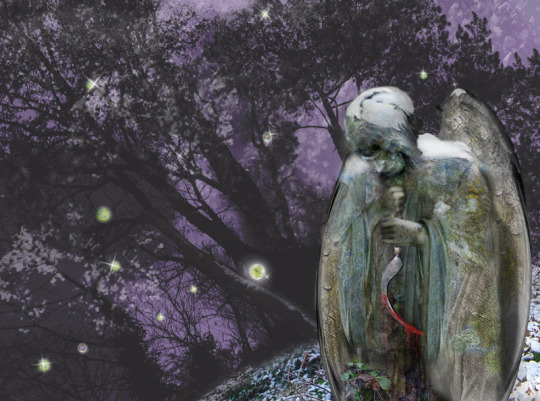
You sent me a sketch for the cover to work from. Do you still draw and paint as well as write?
Actually it was a painting that I made originally to be used as the cover, but Storm wisely said to go with a professional, and your fabulous cover art was the result. But yes, I do still draw and paint, and that all stems from that same early experience of writing and illustrating my own stories. In high school I was co-founder and –editor of the first and (possibly to this day) only literary magazinewhich unabashedly showcased my own art and writing. I was rewarded at the end of my secondary education with an award in Visual Art, received at graduation, but I didn’t pursue it further. I had these lofty and ultimately false ambitions of becoming a veterinarian and was discouraged from continuing with something I was told should be a “hobby” and nothing more; this included writing fiction too, of course. But once I realized that veterinary medicine wasn’t my calling—in fact, it was the appeal of James Herriot’s vet stories at the root of that ambition—I dedicated myself to writing and having my books published, and art did then become a hobby for me, a lovely pastime.
Which speaks the stronger to you creatively and why - pure fantasy or magical realism?
Hmm, that’s a difficult question to answer. I grew up reading mostly pure fantasy. There was even a few years in my teens when I rejected anything but fantasy as a genre, until I clued into the fact that “fantasy” is a massive umbrella term that covered a lot of what in school was deemed as literature. At the time, it was reasonable to read, study and learn from The Tempest, but the novels I was reading were just scoffed at as fantasy—sort of what Victorian writers of fantasy fiction must have experienced when their novels were classified under Children’s Fiction. The same I found was true of horror fiction. Hamlet, if you place it in these diminishing terms of genre, as I see it, is a gothic horror story.
Not to get into a diatribe here, but I’ve always disliked and rejected labels because of this. When I tell people I’m a writer, the inevitable follow-up is, “What do you write?” And no one is content with the desperately accurate reply, “Fiction.” It must be labelled and categorized, which is how it’s marketed.
Okay—sorry, it turned into a little diatribe anyway. Back to the question. It wasn’t until University, where I took courses in Linguistics and World Literature, that I began to really expand my reading taste. And creatively speaking, it’s neither pure fantasy or magical realism, but a mixture of the two and many others that influence me. I know it’s a frustrating answer, but I can’t be more concise than that. Typically, I don’t read the sorts of books that I’m working on at the time. Presently, for example, I’m working on the sequel to Sati and Doghu, an Arabian Nights-flavoured fantasy story, and I’m reading Capote’s Breakfast At Tiffany’s, Tusa’s The Nuremberg Trial, and Hammett’s The Big Knockover, to name but a few.
On the subject of the mundane verses the magical, you recently moved house. I find changing where I create my art can disrupt and even stall my creativity for a while until I settle in and find somewhere I feel comfortable working. Do you need a particular sort of space to write and has moving disrupted that or can you work anywhere?
In truth, it took me a while to adjust, too. Moving is such a big stressor, and moving into your first house, as we did, is rather daunting. I’m still trying to catch up after all these months. I need a certain amount of physical- and head-space to work. It’s easy enough to get into that mental frame of mind…it’s just the procrastination that gets in the way. But the physical space is very important for me. I need absolute solitude and quiet. I’m fortunate enough to have that now, but there have been many periods in my life where I had to painstakingly block-out all the distractions around me. I read long ago how Harlan Ellison did that in the army, writing after a grueling day of training. For painting I can listen to music or audiobooks; but writing, like studying had been for me, must be done in privacy and silence.
How do you feel the mundane and the magical influence and affect your writing generally?
The magical is what I draw from the mundane. I find it impossible to cope with life without an intense level of imaginative revision in my head. I’m always daydreaming. Even when I’m reading, I sometimes have to stop and let my mind finish wandering before I can continue. I love levels and complexity in art. I find I don’t often write straightforward fiction for that reason. The fantastic lends itself to the .
What led you to write your new book, 'Sati and Doghu' and how would you describe the book? Sati and Doghu was originally a novella I wrote quite a long time ago. It was after Indigo Eyes, and I wanted to write something different, something a lot less extreme and for a wider audience. Indigo was always meant to be a cult novel, something to polarize readers and draw a strong reaction, even a negative one. Sati and Doghu has an entirely different agenda.
The idea for the story came in a dream. That’s very unusual for me, because my dreams are usually so distressing and convoluted. I remembered this one clearly the next morning, and I wrote it down, just a sentence or two. Something like: a boy and a coyote, running in the desert—where? The boy was trying to escape something, but he was also being drawn to something else, somewhere else. And I knew their names. Sati and Doghu. And that’s all I knew, and I wanted to find out more. Then I left it. And, as stories sometimes do, it just played out little by little in the back of my mind until I knew enough to put it on a page.
I brought the story out originally in a short story collection, which I sent to Immanion Press. My editor at the time, the author Sharon Sant, suggested I flesh it out into a book because she really wanted to know more of the story.It was the exact same suggestion my wife gave me years before, but I was onto another project and didn’t really want to devote so much more time into a novella. Eventually however, I took the advice, and the rest is history.
I would describe Sati and Doghuas a magical adventure story, inspired by The Arabian Nights formula of nested stories, and about these young characters who are all breaking free of something destructive in their lives and finding their own way in the world. The title makes it sound like a boy and dog story, but Sati’s relationship to Doghu is much more than that. And you have to read it to find out what.
It is the first in a series. How do you feel about writing a series and how many books do you currently plan to write for it?
As Sati was a novella that was later expanded into a novel, I never really intended it to be part of a series. I had a vague idea of events to come, so to speak, but I didn’t set any of this down. I like open-ended stories, stories that live on past the page. It wasn’t until I began the revisions with my current editor at Prospective Press, Jason T. Graves, that I noticed all the loose ends. And it wasn’t until Jason suggested a sequel that I even seriously considered it. I’m working on the sequel now, but I had to put aside another book I was working on to do so, which I’m eager to get back to. But who knows. Some characters, like actors, have to and need to be center stage, and there’s always so much more to tell.
Get Sati and Doghu from: Amazon.com
Amazon.co.uk Amazon.ca
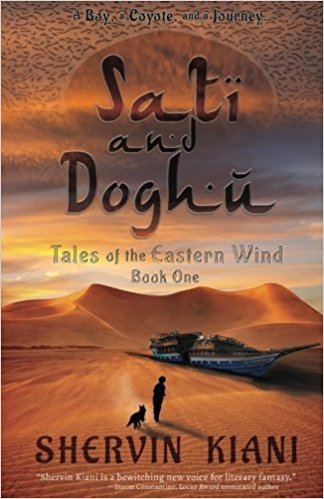
My Review of ‘Sati and Doghu’ The book is an excellent read. I tend to be a bit wary of buying books online having found a fair few that were just badly written and failed to be engaging, but ‘Sati and Doghu’ is not one of those. It took a little while to get into it’s stride, but when it did I found the characters interesting and likeable and found I was hooked. The way their back-stories are interwoven works really well. Magic in the world is fascinating and original. You are not given heavy handed explanations of everything which can alas be a tendency with all too many fantasy books, instead you are given the space to gradually build a deeper understanding of the setting and characters as the story unfolds. While it is marketed as Young Adult Fantasy it is actually very readable if you are older as well, partly I suspect because it does not try to lead you by the nose. Young Adult Fantasy as a genre has been producing some very good new writers with fresh voices and Shervin is definitely, for me, one of them. My only problem with it is that I will have to wait for the next book!
#fantasy#fiction#young adult fiction#young adult fantasy#fantasy art#shervin kiani#peter hollinghurst#hybridartifacts#wrting#creative writing#authors#sati and doghu
0 notes
Text
Fortune’s Wheel update
I have been looking into the possibility of doing a custom deck for Fortune's Wheel for a little while now. One of the options I was looking at was the card site for drivethrurpg as I was going to use drivethrurpg to print the books. While the book section has the ability to print and dispatch in Europe, the card section alas does not seem to at all. I got a shock when I looked at getting a sample deck of one of the ones available there delivered to the UK and the cost of deck+delivery+customs charge was going to be insanely high.
It was always something I was just curious about though - the game can use most standard Tarot decks so it really does not need a special deck for the game. As a Tarot collector I actually rather like the idea of people collecting various decks based on their personal preferences and the game world they are playing in (Fortune's Wheel being a game where you can end up in all sorts of varied different universes).
I have had a few discussions with some of the people who were backers of the Kickstarter attempt or who have found about the game since and ideally if I were to create a deck using an established Tarot deck manufacturer would be the ideal anyway - higher quality cards and boxes being one advantage while the other would be it avoids all the problems of POD deliveries limitations, costs and customs fees for people getting them outside the USA.
As it is, with the very limited time I have now to work on completing the game its not currently a priority (much as I would love to create a deck) as I simply do not have the time. As it is I am now mostly squeezing developing the game into at best one day a week. This was the sort of situation I had hoped to avoid - if the kickstarter had been funded I could have delayed returning to full time work (which for me at the moment means a 57 hour week when I factor commuting in as well) and got the game finished. That didn't alas happen which is why its just occasional updates that I am doing here. What I am probably going to have to do is dedicate my holiday time to working on the game (which will be wonderful, I am looking forward to that) to give it a bit more of a push and get it finished.
All that said, I am still working on the game and have been doing some writing and art for it. In the meantime, the free pdf samples at www.fortuneswheel.co.uk are playable even if they are also just the basics rather than the more ambitious vision I have for the game.
0 notes
Text
Map of Witching - WIP
The Witching map I posted here earlier now has some textures - still a work in progress as I am adding detail. The map will be both for the book and a large poster so it needs to be created for a high resolution. So far I have also only been roughly adding the railway line and roads, and I still need to do a fair bit of work on the real world part of the map showing parts of Devon and Dorset as well. The map should give a good idea of the terrain and locations - I still have some more coastal textures to add - beaches and swampy marsh areas and the various tidal salt marshes around the north and north west side of the island. Some sort of texture to show the extent of the various towns is another possibility as well. The image is quite large if you want to see the detail and location names properly just view the image with a right click and magnify...
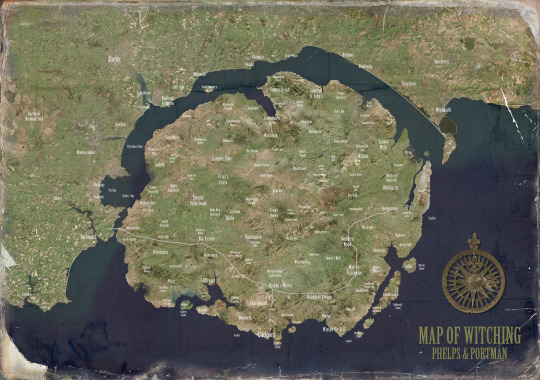
0 notes
Text
History of Witching
Alongside creating the actual hidden county of Witching for the Fortune’s Wheel rpg I have been creating it’s history. A key event in the 20th century was the destruction of Irongreene Castle during World War II. One of the illustrations I have done for the game book shows the aftermath the day after the bombing with a crashed Heinkel bomber and some of the Knights of the Rose searching the area for the crew. Since that day suspicions for some of the Knights have grown that far from being the accident it first appeared to be it was a deliberate attack. Did someone guide the bomber through the magical defences of the Witching Fold to the wrong target? Why did they target Irongreene? Was it to destroy the castle or to kill key members of the Knights of the Rose within? This is event is one of the mysteries people playing the game can investigate.

#fortunes wheel#bomber#castle#fantasy#dark fantasy#rpg#rpgs#Tabletop RPG#Tabletop role-playing game#roleplaying games
0 notes
Text
More Art for Fortune’s Wheel
I may still tweak this one a little, but otherwise it is done. It shows three Knights of the Rose in Hawkshill Place (the Court of Air’s ancestral home) building a shard with the Tarot.
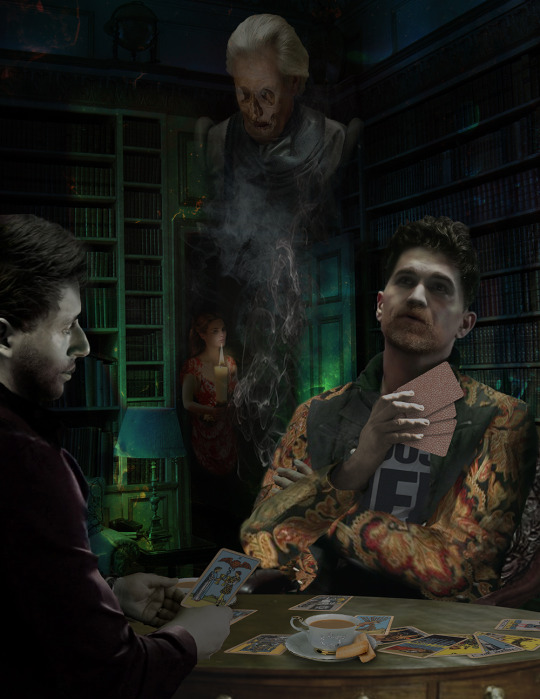
0 notes
Text
An Interesting Kickstarter
If you are interested in the Tarot and storytelling I would recommend checking out this Kickstarter Project - ‘The Writer’s Block Tarot’. It looks as if it would also make a useful deck to use when playing Fortune’s Wheel. It is fully funded but still has a while to go if you want to jump on board and support it.
https://www.kickstarter.com/projects/1962286285/the-writers-block-tarot/description
0 notes
Text
New Art
One of the larger Domains on the Erebus map is that of the Fey Courts (or Fae if you prefer - I think I shall change that on the map as I tend to use Faerie). So here, for your delectation and delight is one of the Fae:
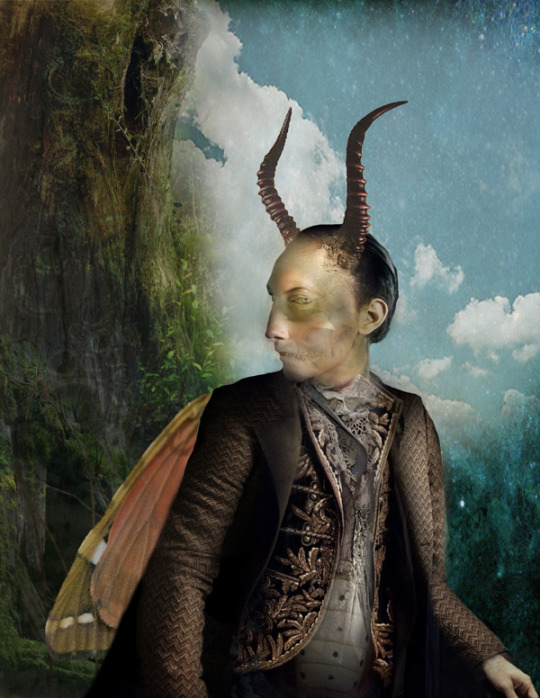
This is Lord Gloamspite, a Faerie Lord of the Autumn Court. Or at least this is how he chooses to look most of the time... the Fae are masters of ‘glamour’, the magical art of illusion, and tend to look like whatever they ant you to see. Amongst the Fae their appearance (what they call their ‘seeming’) is something they take great pride in and have often spent centuries perfecting. Some say that their real appearance is a mystery because they never show it while others say it is unknown because they actually have no visual appearance at all save what they choose to show. The Fae are the dominant faction in the Erebus and tend to roam throughout the other Domains fairly freely, both creating and absorbing Realms there into their own Domain. From the game book:
The Fey Courts are based around the four seasons, each with a Faerie King and Queen served by Knights and pages just like the Knights of the Rose (KOTR). This has led to some speculation that the KOTR and even the Tarot may be structurally based on an initial contact with the Fey or vice versa. There was also once a Great faerie King and Queen who ruled over all four of the Fey Courts, but following a war with the KOTR which the KOTR won by capturing them they no longer have any role in the Fey Courts. By an agreement with the Fey, the Great King and Queen, Oberon and Titania, remain the prisoners somewhere of the KOTR and there is now an uneasy peace accord between the Fey and KOTR called the Covenant.
There is a rumour that the Fey deliberately lost the war by betraying Oberon and Titania because the Great King and Queen were not genuine Fey at all, but Fictions that had gained power over the Fey Courts. The peace that comes with the Covenant is said to be a price they were willing at the time to pay to restore the Fey Courts to their original purity.
The Bound (Covenanters)
The Bound are the Fey who keep to the Covenants signed between them and the KOTR. They generally don’t like it, but seek at least for now, to avoid another all out war and maintain peace. Having sworn to keep the Covenant they cannot directly break it unless the KOTR break it first, but they can subtly subvert it and the KOTR suspect some Covenanter's may be indirectly helping the Rebel Fey.
The Unbound (Rebels)
The unbound do not see the Covenants as legally or magically binding in any way, never having agreed to them because they were absent for one reason or another when they were signed, and they are still fighting the war with the KOTR. Because their numbers are limited and casualties will reduce them even more they tend to fight it now as a guerilla or terrorist war with the occasional hotspot in a world where all out warfare has developed between them.
0 notes
Text
A Map of the Erebus
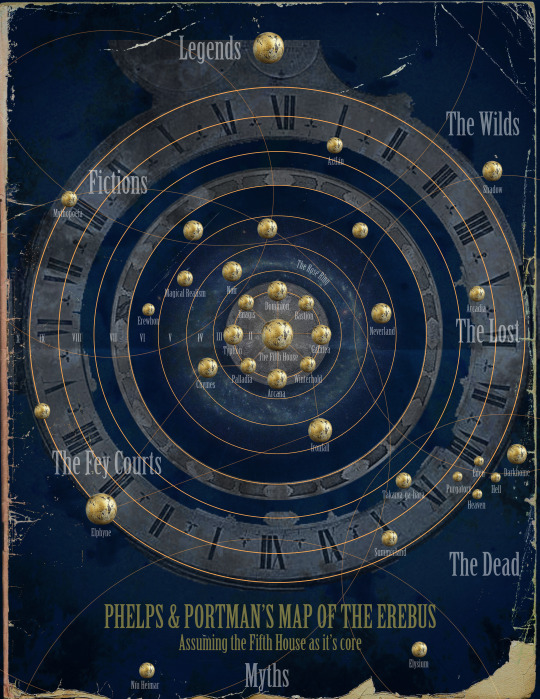
Still a work in progress but nearly complete. The Erebus is the main conceptual idea underlying the game setting for Fortune’s Wheel. The map is showing a three dimensional space - the gold spheres are pocket universes or ‘Realms’ - the bigger they are the closer they are to someone looking at the map. They exist in ‘Domains’ - clusters of themed Realms. The Domains are bounded by the thin gold circles. The thicker gold circles radiating out from the centre are distance markers with Roman numerals in each band indicating a difficulty rating to get to them from the centre. The clock face is for giving co-ordinates on the map, so Ironfall is at dexter (for the right hand side) between X-XI on the clock and in the difficulty/distance zone V or D.X-XI.V. If it was on the left it would be sinister or S.X-XI.V. The map is based on a sot of geocentric approach with out world (the Tellus) in the middle represented by the Fifth House, the base of the Knights of the Rose, that sits on the sole remaining entry point to the Tellus guarding it from unwanted incursions from the Erebus. Here is a bit form the game book on the Erebus:
Hidden and jealously guarded books tell us The Erebus was nothing. It is contradiction because it is a thing that really does not exist – it is the absence of things, a hole. It is the absence of light, so it is dark, it is the absence of matter so it is a void, it is the absence of time so it is eternal, it is the absence of order so it is chaos, it is the absence of goodness....so it is evil. It is everything we dread – the negation of light, hope, joy, life and love. It is the end of everything.
And yet that very absence demands the opposite – by its very negation of all things it makes all things all possible – if it is the absence of light then it means light is possible, if it is the absence of matter it means matter is possible, if it is the absence of time it means time is possible, if it is the absence of order it means order is possible, if it is the absence of goodness it means goodness is possible. Within it lies the seeds of everything that might give us hope and could bring us life. Somehow a force even greater than the Erebus balances it and exceeds it and because of that other force a key turned in the dark and its potential was unleashed... and there was light, and matter and time and the First World formed in the Erebus – a universe – our universe, was born. Alchemists have suggested the Erebus is really the prima material, the primal stuff of everything that the four elements divided from to form the Tellus. They say it is the Quintessence – the fifth element.
In the beginning the First World, the Tellus, was all there was, but as sentient life began to emerge a strange thing happened in the Erebus – it began to create mirrors and echoes of our dreams and musings – as we created and imagined the Erebus copied us and what we had in mind. Through this the Erebus ceased to simply be nothing and was filled with other worlds. Worlds inhabited by legends and fictions and ghosts. It has been called the land of the dead, and also the land of Faerie. Mystics say the ghosts came first – tiny shards of our lost loved ones and our enemies that grew and grew and became the gods and monsters of our myths. Others say that the gods were actually the offspring of greater beings – titans or angels that were destroyed or imprisoned in a great war before human history began and the faeries are their offspring, while others say we are their offspring or the descendants of a mix of humans, gods, angels and faeries. They say that war caused the holes and rips between the Tellus and the Erebus that acted as doorways between the two and that the Tellus was previously sealed from the chaos and the dark. Some even say the war was the revenge of the Erebus for all the things that had formed in it and that it became sentient itself and simply hates us.
There are a great number of stories though and nobody really knows which are true. Perhaps there are glimmers of truth in many of them but ultimately it is a mystery. What then do we really know about the Erebus? It is certainly dark and vast and timeless. Many universes, worlds and small pocket realms certainly do exist within it. They really do form from our imagination and conscious and subconscious thoughts - people have actually seen it happen and it is possible to find worlds where fictional characters mingle in fictional versions of cities and countries. The Erebus seems to act like a sort of creative soup of darkness that responds to creative intelligence. The dead do seem to turn up there a lot and often mingle with them. Sometimes they seem to know they are dead, sometimes they do not and think they are dreaming. There seem to be an awful lot of faeries that live in the Erebus in various magical kingdoms and they have their own realms based on the four seasons. The Knights of Rose spend a lot of time and energy trying to restrain their power resulting in numerous wars with them. Currently there is an uneasy peace with the Faerie courts, but there are rebel fey who still fight on, so the Knights are always raising armies on various worlds to repel their attacks.
It is possible to find any sort of world you can imagine somewhere in the Erebus if you look hard enough. It is worth remembering though that time does not move in the Erebus itself, so you can easily spend what feels like only a very short time exploring the Erebus only to find that many months have passed in the Tellus or on some other world within the Erebus. Sometimes imaginary worlds cluster together, so you might find various Fictions with a Victorian feel to them all on the same world – Sherlock Holmes and Captain Nemo might share a reality and mingle together in society there. Sometimes you might also find variant worlds because different stories exist about the same character – so there may be a Steampunk version of Holmes and a more historical one, and in theory you could take each from their own world and have them meet. Getting characters to leave their world and enter another one can be difficult, but it is not impossible. In theory if you wanted to assemble an army of characters from different legends and stories and give them all laser guns, you can. It is also quite possible that some character in the game is actually already doing just that...
Some of the places you might find in the Erebus are actually just very small pocket realities, usually called ‘realms’. These can be as small as a single building floating in the Erebus or as large as a continent. Any bigger and you would be looking at a world. If there are multiple worlds in the pocket it is starting to verge on being a universe and once you have multiple systems of worlds you definitely have a pocket universe.
1 note
·
View note